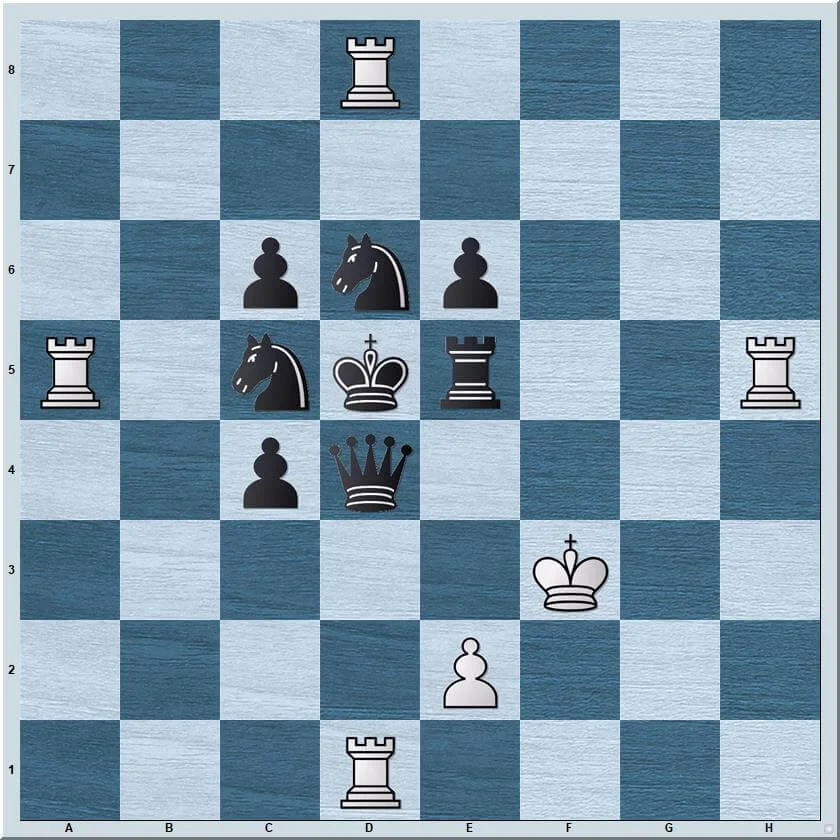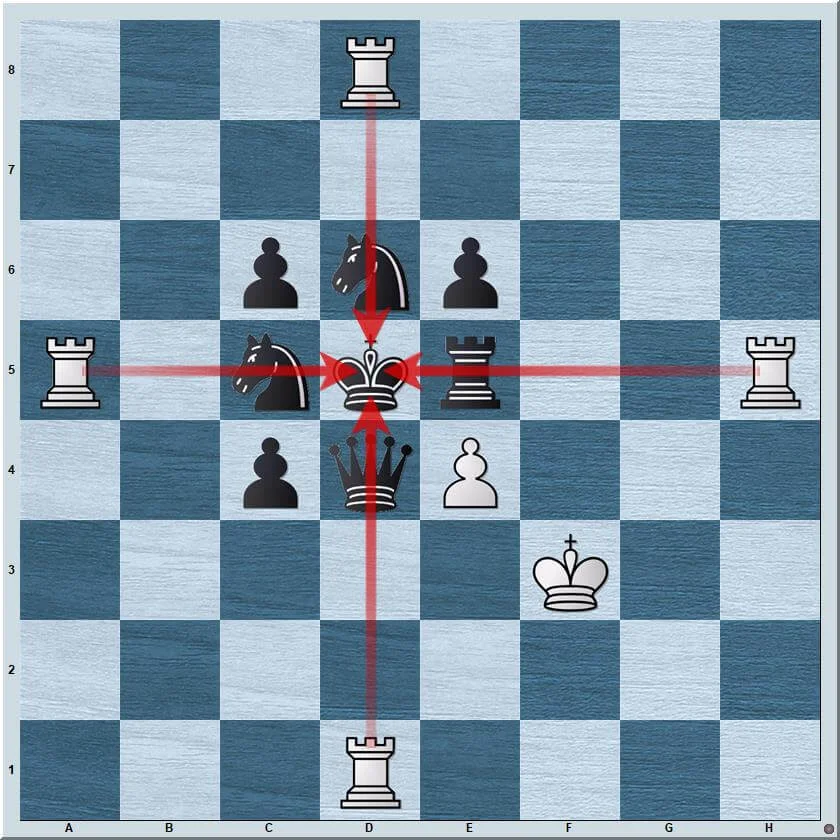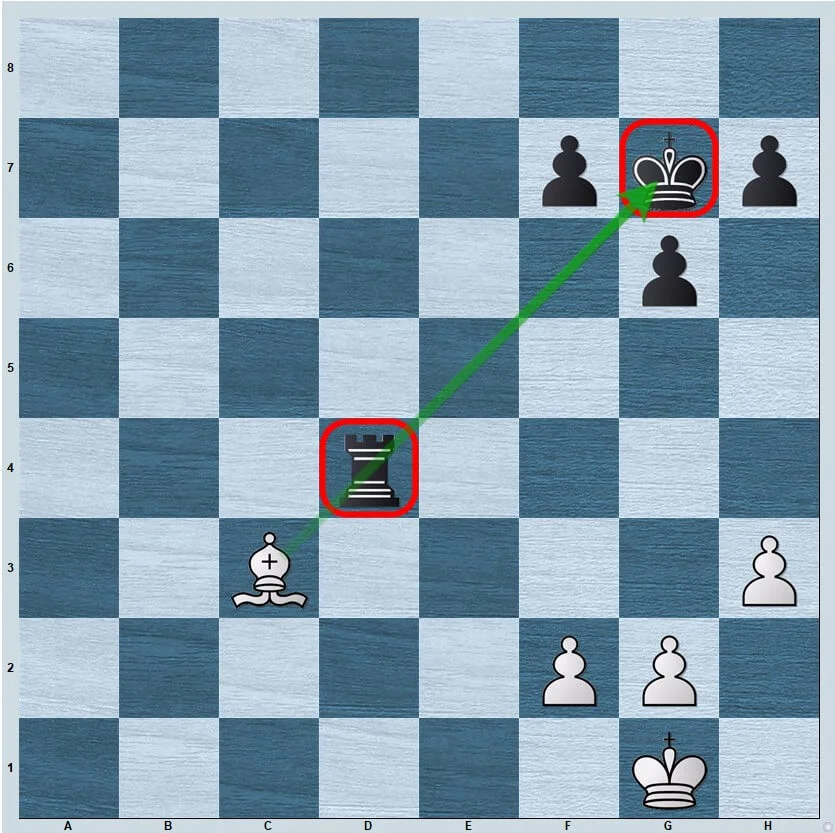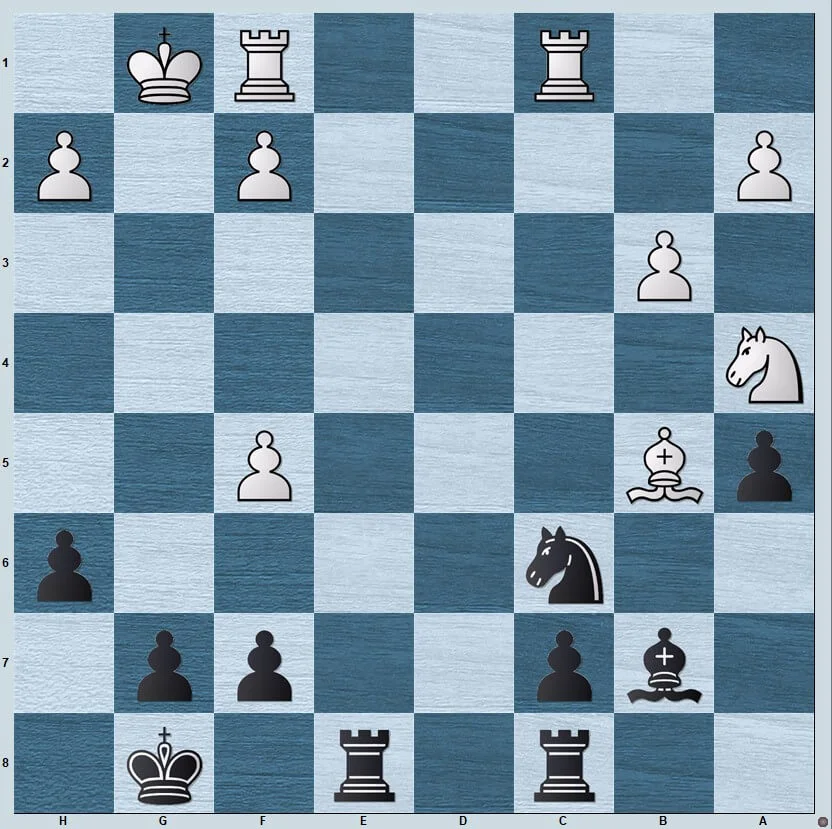The Pin Tactic in Chess Explained by a Grandmaster [For Beginners]
Everything about the pin in chess tactic: from what it is, how it works to how to get out of it and more!
Everything about the pin in chess tactic: from what it is, how it works to how to get out of it and more!
![The Pin Tactic in Chess Explained by a Grandmaster [For Beginners]](https://cdn.chessmood.com/chessmood/images/articles/846/the-pin-tactic-meta-and-main-at-4x-2-1webp_65058a616294f.webp)
Can you find the checkmate in 3 seconds?

While it looks really crazy to checkmate Black King surrounded by the defenders there is:
1.e4!! mate.

There are 4 Black pieces capable of capturing but none of them can.
They are all pinned!

One of the most important tactics is the pin in chess! Mastering it is one of the first steps in chess tactics training.
Here, I’ll get a short overview of some of the most important concepts of this tactic as you’ll see:
And at the end, I’ll give you some test puzzles to solve this tactic.
Before we continue, I’ll offer you a position to solve.

It’s Black to play. Their Queen is pinned, and it seems they’re losing. Or is it?
Can you find a way to save the game for Black?
*
*
*
Bravo if you managed to solve it, and it’s absolutely fine if you didn’t yet. This is a little advanced example from the cross-pin topic.
The answer is covered in the article's final section, where you’ll also find a free resource on this topic from a detailed chess tactics course.
Let’s start from the basics!
A pin in chess is a tactic that occurs when a piece is pressured, and if it moves, it exposes a more valuable piece or target behind it.
Here’s a simple example.

This is a pin – White’s Bishop on c3 attacks the Black Rook on d4, which cannot move because the Black King on g7 would be exposed.
The piece which is pressured and cannot move when under a pin is called the pinned piece – in this case, the Black Rook on d4.
The piece that creates the pressure (Bc3 in the above example) is known as the pinning piece.
The above example is an absolute pin. You might wonder what’s that.
A little later, we'll discuss the different types of pins, and you’ll find out. But before going there, let’s understand an important detail.
From my experience, I’ve noticed 3 common reasons for using this tactic:
Later I’ll show you practical strategies along with examples of using this tactic in real games. For now, let’s finish with the basics.
All the long-ranging pieces can create a pin.
The Rook

The Bishop

The Queen


The King, Knight, and pawns cannot.
You need a magnifying glass… Just joking😀
Look, you already saw which pieces are capable of giving a pin.
How do they move?
On files, ranks, or diagonals!
So when the opponent’s pieces are lined up together on the same file, rank, or diagonal, there will be opportunities to pin!
Easy to remember right?
There are 6 different types:
In an absolute pin, the pinned piece cannot move. That would cause an illegal move. This happens when the King stands behind the pinned piece like you saw in this puzzle.

Black Rook is pinned, and can’t move because it would expose the King.
What if instead of the King, we put a Queen and the Rook could legally move? That brings us to the next type.
The pinned piece can make a legal move in a relative pin, but it would be unfavorable because it would still expose a more valuable piece behind it.
Take a look at the puzzle below:

White’s Bishop pins the Black Rook on d4. And even though the Black Rook can make a legal move, moving it will expose the more valuable Black Queen behind it.
As you can see, it’s quite similar to an absolute pin, with the only difference being that the vulnerable piece behind it isn’t the Queen.
Can a chess pin occur when there’s no valuable piece behind it? Yes, it can, as you’ll see next.
In this, a pinned piece might be blocking access to an important square. Take a look at this example:

White plays 1.Rb1! Creating a situational pin.

And now if Black moves away his Bishop from the b-file with 1…Bxd5, then White plays 2.Rb8 checkmate.

The next type is very pleasing to the eye!
This type of pin occurs when a piece is pinned from two directions. It looks very majestic!
In the position below, it’s White to move.

Is it completely equal?
Or there’s a way to turn things around?🙂
Surprise! White has 1.Qd4!

Look at the Black Rook on d7 for a moment. Capturing the White Queen is impossible because the White Rook eyes the Black King on g7. On the other hand, if it captures the White Rook, the Black Queen on d8 falls.
It’s pinned on the d-file as well as the 7th rank!
Beautiful, isn’t it?😀
That’s a cross pin!
There’s another pin type that can paralyze the opponent’s pieces.
This is one of the deadliest types of a pin. It occurs when the defending side cannot get out of a pin. Surprisingly, it’s not covered a lot in chess literature, so many players don’t know about it.
Here’s an example.
This is my favorite Pin type.
In the position below, it’s White to move. Their Rook is under attack.
What would you play?

If you decide to retreat, it’s not a disaster. White is still doing better as Black’s King is stuck in the middle.
The thing is Black’s 2 pawns are pinned by the Queen and Bishop. We have a fantastic resource 1.Rd5!!

In the position below, it’s White to move. Their Rook is under attack.
What would you play?
Black can’t capture the Rook and additionally, Bishop on d6 is pinned.
This was the last type.
Now I’ll show you some common ways to execute this tactic in your games.
Let’s begin with one of the most popular ways.
The more pressure you put on a pinned piece, the harder it becomes to defend.
And when you put pressure using a lower value piece, the pinned piece is most likely going to fall!
A classic opening strategy you’ll see is the Bishop pinning the Knight.
Why is it so popular? Because:
Remember a pinned piece can’t move freely. This means you could access the squares they control!
If the King is the one taking cover behind, the pinned piece is on a hospital bed, absolutely paralyzed. It just can’t move!
Here’s a famous trap from the Caro-Kann opening that shows this idea in action!
Pins can be very dangerous!
What if you’re the one who ends up falling into it?
I remember once Lily, the head of our happiness team, was playing an online match when she got stuck in a pin, I could sense her frustration.
All of Lily’s attention was on the pin. It was as if she couldn’t think of anything else.
The position looked a bit like this.

Black has just pinned the Knight.
And now Lily, desperately trying to get out of the pin, played 1.Qe2. She wants to go Qd3 next, but here opponent played 1…Qf5! All of a sudden, White’s position gets uncomfortable.
Black’s threatening to play Rhe8 next.
Instead of 1.Qe2, Lily had a much better option. In fact, she had plenty of great options. I’ll come back to the position and show you all those options.
What I know, though, is that Lily’s not alone. Many players get irritated and annoyed when they get stuck in a chess pin.
Fortunately, there are many ways to escape from it, and here I’m going to show you 10 of the most common ones:
This is one of the simplest ways. Here, you just move the vulnerable piece out of the firing line in a way that it still defends the pinned piece.

For example, in the above position, Black’s Bishop pins the Knight on f3.
White can just play 1.Qd3 and step out of the firing line.
In some situations, you’ll also have the option to give a check and then escape out of the firing line, as in the position below.

White plays 1.Qa4+ Kf8 2.Ne5, allowing them to get out of a pin.

White has not just got out of a pin but also has a winning advantage.
Here, you first protect the pinned piece and then move the piece standing behind in the firing line.
Like in the position below:

This is a very simple and popular way. You don’t overprotect the pinned piece while also put a barrier between the enemy’s attacking piece and your vulnerable piece behind.
I’ll give you an example.

The Black Bishop pins the Nf3, making it very uncomfortable for the White Queen. So what can White do?🙂 The simplest option is to take cover with 1.Be2!

White overprotects Nf3 and puts a barrier between the enemy Bishop and their Queen.
Often in opening and middlegame positions, you can use pawns to kick away the pinning piece.
For example, look at the example below.
It can be very tempting to get out of a pin in chess this way.
But because pawns don’t move backward, they could create weaknesses in the position that would be very hard to repair.
So be careful, especially if you’re pushing pawns in front of your King!
You can also get rid of the pinning piece by exchanging it.
Take a look at the position below.

It’s Black to play. White threatens g5 next move, winning the Knight. So Black must exchange the White Bishop with 1…Bd4!

Once the Bishops are off the board, the Black Knight is no longer pinned.
The name speaks for itself – you neutralize the pin by pinning the pinning piece! Here’s an example to make things clear:

The Black Bf5 pins the White Rook and King. So what does White do? They counterpin with 1.Bg4!

Now Black is forced to exchange the Bishops and White saves the day!
In some cases, you can just treat your pinned piece in a way that it defends the vulnerable piece behind.
Take a look at the position below.
What if you can move the pinned piece and create a threat of your own?
Yes, it would expose your vulnerable piece behind.
But if the threat you create is dangerous enough, your opponent would have to defend against it.
Here’s a practical position. It’s Black to play.

It seems like the pinned Knight is lost. Or is it? 😊
Think before you see the solution below.
I’ll leave you with a slightly advanced strategy that you’ll often see stronger players use. For this, you need to have a good understanding of all the other tactical patterns in chess.
Let me show you a simple example.
In the position below, Black has just captured the pawn with 1…Qxh3.

And now the g2-pawn is pinned. It seems like White is busted, until the annihilation tactic saves the day!
These are just some ways to get out of a pin in chess.
As you learn other tactical patterns, you’ll figure out many other ways yourself.
For now, these 10 ways to escape from a pin above should be more than enough.
Remember I told you we’ll come back to the position at the beginning of the article? So here we go!
Now that you know the different ways to get out of a pin, can you see how the different options White has in the position below?

Apply the things you've just learned. You can see White's options in the game below.
Now that we’ve covered the fundamentals of this tactic, I’ll offer you a few test puzzles.
We will start from the position I showed you at the beginning.
Now we move on to the next position...
And now the final position.
Did you manage to solve the examples? How did it go?
To improve your tactical vision for this tactic, you can watch the fully unlocked Pin section of our Tactic Ninja course.

We covered the fundamentals of one of the most common tactical patterns in chess.
Whenever you win a game with the nice Pin tactic, post it in the ChessMood forum. I would love to see it!
Good luck Champions!
Yours,
GM Gabuzyan
Grandmaster Guide to learn and improve chess tactics
Originally published Mar 16, 2023

